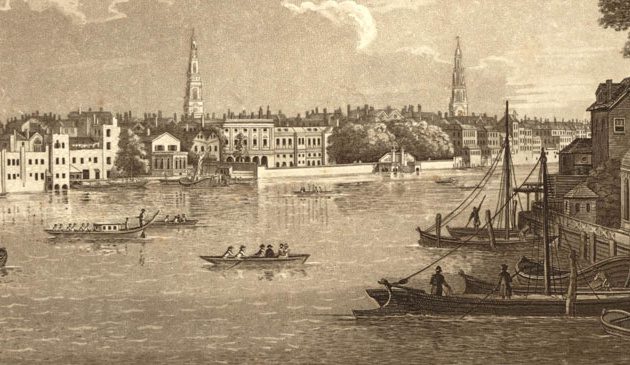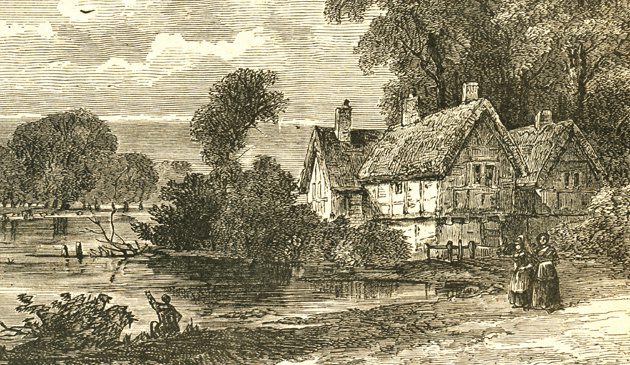The rebuilding of St.Paul’s Cathedral after the Great Fire of London

An engraving of Wren’s ‘Great Model’. King Charles requested that Wren produce a model of his design and it took about a year to create. It now resides in the trophy room at St. Paul’s.
The mighty St. Paul’s Cathedral, the mother church of London and the seat of the Bishop of London, was severely damaged in the Great Fire of London of 1666. Lacking in funds and man-power to rebuild the cathedral, services continued in the ruins and some repairs took place. In the spring of 1668 part of the nave collapsed and it became clear that a more permanent solution was required.
The building had already been in a poor state of repair prior to the fire. A week before the conflagration King Charles II had commissioned three surveyors, including the scientist Dr. Christopher Wren, to consider ways to patch up the medieval building. Wren produced a radical and controversial solution that involved replacing the square tower with a large dome. In 1669 Wren succeeded John Denham as the Surveyor of St. Paul’s.
By 1670 it was clear that St. Paul’s Cathedral would need to be completely rebuilt but how could it be funded? To rebuild roads and public buildings that had been destroyed in the Great Fire a tax of one shilling per chaldron on coal entering London for the following ten years had been instigated in 1667. The tax was extended in 1670 to all ports and harbours along the Thames Estuary, increased to three shillings, and lengthened by a further three years, with three sixteenths of the income allocated to St. Paul’s. By 1685 St. Paul’s and the City churches were far from complete and the collection of the coal tax was again extended by Parliament until 1700, with 60 per cent going to the cathedral.
Aware of the lack of funds, Wren’s initial plan, known as the ‘First Model’, involved building on the original foundations and was only around one third of the size of the final building. It was rejected as too modest by the Dean and Chapter. His next ideas of 1670-1672, known as the ‘Greek Cross’ design, which evolved into the ‘Great Model’ design because the King ordered that a large model of it be built were in the classical style, with the central section of the building below a large dome. A domed building was rejected by the churchmen as too radical – or perhaps too Catholic or foreign – and they pushed for one in the traditional cross-shape of a medieval cathedral.
There was less income from the coal tax than anticipated and it was only in November 1673 that a royal warrant for the complete rebuilding of St. Paul’s was issued, with Wren as the architect, to be overseen by the Lord Mayor of London, the Dean of St. Paul’s, the Archbishop of Canterbury, and the Dukes of Buckingham, Albermarle, Lauderdale, and Ormonde amongst others.
Demolition work on the remains of the former building was a major undertaking. More workmen died during the demolition than reported deaths during the Great Fire. After the men refused to climb the great tower Wren, working with an engineer from the Tower of London, experimented with a new technique involving dynamite. The first explosion successfully brought down much of the cathedral’s main tower, with the subsequent falling of masonry making the ground shake as it would from an earthquake. Having commitments elsewhere, Wren delegated the work of further dynamiting to his colleague Robert Hooke. He overestimated the amount of gunpowder required for a second explosion, resulting in debris flying through a nearby house and narrowly missing some women who were working there. Following complaints, Wren thereafter reverted to a battering ram.
The final formal proposal – the ‘Warrant’ design of 1674-1675 – was of a more traditional plan and spire but in the classical Baroque style popular at the time. This version was approved by King Charles who added the proviso that Wren was able to make “variations, rather ornamental than essential” and building work finally began, nine years after the Fire.
From 1668 Wren was assisted in the project by Edward Woodroffe until Woodroffe’s death in 1675. The building contractor for the work was the master builder Thomas Strong who worked together with Wren on the project for 35 years. In later years John James, who had been working for Wren on the building of Greenwich Hospital, was appointed senior site manager.
Wren personally supervised the building work, visiting the site every Saturday. The 14th century octagonal chapter house on the south of the cathedral was used as his site office, surviving in part until 1714. Despite a shortage of construction labour during the rebuilding of London after the Fire he hired only the finest artists and craftsmen.
As the building work progressed behind scaffolding, and unseen by the clergy, Wren was able to use the King’s proviso to make a large number of changes to the design. The final building bears very little resemblance to the plan, most notably reverting to the large dome of the previous Greek Cross design and adding the grand west main entrance and towers. In fact, Wren had clearly intended to change the design from the beginning, laying eight central pillars with foundations and diameter far greater than required to support the modest structure approved by Charles II.
Construction took 33 years and spanned the reigns of five monarchs. In part it was held up by difficulties in obtaining supplies of Portland stone. In 1690 naval action by the French in the English Channel prevented supplies coming by ship from the south coast, and then in 1696 heavy rains caused a cliff to collapse at Portland, destroying cranes and the loading platform. Parliament suspended half of Wren’s salary of £200, believing work was progressing too slowly. Indeed, an employer of the time could chide an employee as being “as slow as a St. Paul’s workman”. Wren received the arrears on completion in 1710. The first service in the unfinished building was a thanksgiving for the Treaty of Ryswick in December 1697 held in the quire, at which time the dome was still to be erected.
The most distinctive point about the post-Fire St. Paul’s is Wren’s great dome. However, at the outset it was probably not clear even to Wren how his intended great cupola could be achieved as there was at that time nothing he had witnessed with which to compare his vision. He later explained that his model was the Hagia Sophia mosque in Istanbul. The Frenchman Guillaume-Joseph Grelot had visited there, where he was allowed to take measurements, and he published his account in 1680, translated into English in 1683 as A Late Voyage to Constantinople. Grelot’s patron, John Chardin, had also travelled to the east, taking with him two artists to record the places he visited, and in 1680 came to London where he was invited by Wren and John Evelyn to give a lecture at the Royal Society on his observations. Shortly afterwards Chardin settled in London, and Wren and Evelyn visited him at his home. Plans were subsequently made of the Hagia Sophia, possibly drawn up by Nicholas Hawksmoor and based on conversations with Chardin.


